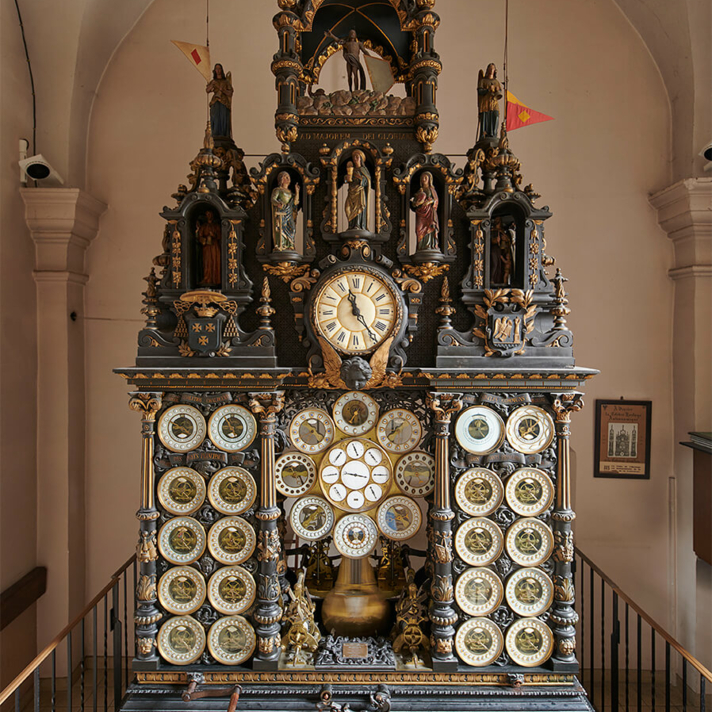History
article | Reading time7 min
History
article | Reading time7 min
The astronomical clock of Besançon is a masterpiece displaying the technical prowess and artistry of its designer, Auguste-Lucien Vérité. The massive clock stands at five metres tall and weighs a hefty two tonnes. Are you ready to discover all the secrets of this extraordinary timepiece ?
An astronomical clock is a clock that, in addition to indicating the time of day, provides information about what’s happening in the cosmos, such as the relative positions of the sun and the moon, Earth’s position on its orbital plane, the positions of the zodiacal constellations, etc.
An astronomical clock can also provide information on various cycles, such as the durations of day and night, the age and phase of the moon, the dates of eclipses, of Easter, of the tides, of the solstices, solar time, a map of the sky, and more.
There is proof of similar devices existing since antiquity (like the Greek Antikythera mechanism or the Tower of the Winds in Athens). However, the term “astronomical clock” did not appear until the 14th century, along with innovations introduced by the mathematician Richard of Wallingford.
With its 30,000 parts and its 60 dials giving 122 different indications, all of them interconnected, the monumental clock at Besançon Cathedral of Saint John perfectly fits the definition of an astronomical clock.
© Benjamin Gavaudo / Centre des monuments nationaux
The astronomical clock of Besançon Cathedral was designed and built by the clockmaker and mechanical engineer Auguste-Lucien Vérité from 1858 to 1860, at the request of Archbishop Mathieu. It was officially listed as a French historical monument in 1991. It took two years of technical work and three years of ornamental work to complete the clock.
It was installed in a room near the base of the bell tower, where it stands at the centre of a very important mechanism. The astronomical clock ensures that the clocks for timekeeping inside and outside the cathedral, as well as two bells in the steeple, operate according to plan.
In addition to providing many different pieces of information and ringing bells to announce religious services, the astronomical clock is also a public clock, meaning that it rings bells on the hour and keeps time for the people of Besançon. The clock has six levels, with some of its connected dials putting the machine’s total height at 27 metres.
A true masterpiece of engineering, the astronomical clock serves as the beating heart of the cathedral’s bell tower. A series of iron shafts extend out from the belly of the beast, transmitting motion to the hands of the cathedral’s five clock faces and ringing the bells at the top of the tower. A system of mitre gears and mechanical transmission keep the different mechanisms perfectly synchronised.
The astronomical clock is made up of over 30,000 mechanical parts and includes 122 different indications, all of them interconnected, including the time in 20 different places around the world, the number of upcoming lunar and solar eclipses, the season, and—an unusual bit of information for Besançon—the dates and times of the tides !
© Benjamin Gavaudo / Centre des monuments nationaux
Indeed, a first astronomical clock was installed by Constant Flavien Bernardin from 1851 to 1857. However, the mechanism was far too complex and it very often malfunctioned. As such, it was quickly abandoned.
In 1857, Archbishop Mathieu asked Auguste-Lucien Vérité, a renowned master clockmaker in Beauvais, in France’s Picardy region, to design a new astronomical clock.
The ornate clock, gilded with gold leaf, is equally impressive for its beauty as for the ingenuity of its mechanism. Auguste-Lucien Vérité put every bit of his expertise into creating the clock. It is also a showcase for technical progress made in the 19th century.
© Benjamin Gavaudo / Centre des monuments nationaux
In the last several decades, the astronomical clock has had frequent problems and has often been stopped.
The Burgundy-Franche-Comté Regional Office for Cultural Affairs decided in 2021 to commission a study on the condition of the clock in order to take adequate measures for its preservation. Since then, the clock has been stopped out of necessity and it will soon be restored.
The restoration is sure to be complex, as the clock is computer-automated and the technicians will have to get the mechanisms working again according to calculations made over 150 years ago. For example, there’s the “Chaldean cycle”, which Auguste-Lucien Vérité calculated would only complete its first full cycle around the dial in the year 2400 !
Want to explore the details of this ingenious system ? How about we take a look at the central unit ?
© Alain Lonchampt / Centre des monuments nationaux




